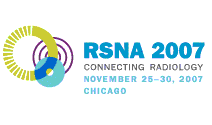
Abstract Archives of the RSNA, 2007
Nisha Sainani MD, Presenter: Nothing to Disclose
Raul Nirmal Uppot MD, Abstract Co-Author: Nothing to Disclose
Bruce Sands MD, Abstract Co-Author: Nothing to Disclose
Dushyant V. Sahani MD, Abstract Co-Author: Researcher, General Electric Company
Consultant, Bracco Group
Assess efficacy of small bowel labeling in CTE with positive & neutral oral contrast in diagnosis of complications of Crohn’s and recognize value of coronal reformatted images in diagnosis and readers confidence.
60 patients (33M:27F, Age16-80 yrs) of Crohn’s who developed complications were evaluated by CTE on 16-MDCT (GE) with 5 mm slice thickness and 2-3 mm coronal reformats. 30 patients received neutral oral contrast media (NOCM) (1250 ml of VoLumen + water) and 30, positive oral contrast media (POCM) (900 ml of barium/gastrograffin). Two readers recorded characteristics of Crohn’s, presence & conspicuity of complications, which were confirmed on follow-up imaging/endoscopy/drainage/surgery. Statistical analysis was performed using Wilcoxon rank sum test.
Complications noted were: abscesses (n=45), fistulas (n=21), perforations (n=6), strictures (n=50) & small bowel obstruction (SBO) (n=42). Detection of abscess, fistulas, perforations, strictures & SBO with POCM was 85/89/75/82 & 89% respectively; that with NOCM was 76/81/75/87 & 91% respectively. Detection of abscesses and fistulas was better with POCM but not statistically significant (0.21&0.65), though reader’s confidence was higher with POCM (4.7&2.7) than with NOCM (2.7&1.6). There was no statistical difference in detection of perforations, strictures & SBO with PCOM & NOCM (0.09,0.55&0.31). Both readers appreciated bowel enhancement & wall thickening with higher confidence, with NOCM (4.8&4.8) as compared to POCM (2.9&2.8). Inter-reader agreement was good for all findings. Coronal reformatted images supplemented axial data set with POCM & NOCM for the detection of complications in 36 cases & improved reader’s confidence in 20 cases.
CTE, using a positive & neutral OCM has a comparable performance in detecting complications of Crohn’s. Although bowel wall changes were better appreciated with neutral OCM, bowel labeling with a positive OCM allows more confident detection of the extra-luminal complications. Coronal images complement axial data set in evaluation of complications.
Choice of OCM for CTE exam can be rationalized to improve detection of complications.
Sainani, N,
Uppot, R,
Sands, B,
Sahani, D,
CT Enterography (CTE) with Positive and Neutral Oral Contrast: Impact on Assessing Crohn’s Complications. Radiological Society of North America 2007 Scientific Assembly and Annual Meeting, November 25 - November 30, 2007 ,Chicago IL.
http://archive.rsna.org/2007/5009690.html

